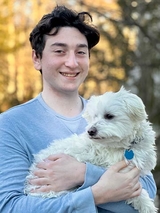Brandon’s Story: Ketogenic Diet Cures Myoclonic Atonic Epilepsy
Brandon’s Story: Ketogenic Diet Cures Myoclonic Atonic Epilepsy
Brandon has gone from enduring dangerously uncontrollable seizures as a young boy to being seizure- and medication-free for the past 10 years after starting the ketogenic diet with the help of the Dietary Treatment Program at Children’s Hospital of Philadelphia.

Brandon was a happy, sweet little boy who was developing normally until age 3, when he had a seizure while his family was on vacation.
“It was very scary,” says his mom, Dawn. “He literally fell down and started shaking out of nowhere.”
The family spent most of the next several months in and out of hospitals. At a hospital in New York City, Brandon underwent an electroencephalogram (EEG) that recorded his brain activity over the course of several days. Based on that study, he was diagnosed with myoclonic atonic epilepsy (MAE), also known as Doose syndrome.
Brandon was prescribed a combination of medications to control his seizures and discharged back home to Marlboro, NJ. But the seizures only increased in frequency and severity. Dawn was afraid to be alone with him, so her husband, Steven, began working from home. Brandon had to wear a helmet and the family put padding over their hardwood floors so he wouldn’t injure his head when he had a seizure. They even put cameras in his bedroom so they could monitor him at all times.
“It was a crazy, stressful time in our lives,” recalls Dawn.
Dawn was desperate to find a treatment that would help her son. She read a story online about a child whose seizures were cured by the ketogenic diet. It was 2009, and the diet hadn’t yet become the popular weight-loss strategy it is today, but it had long been used to treat epilepsy, and was known to be particularly effective in controlling MAE.
At first, Dawn was worried it would be too difficult to adhere to such a strict diet. But when Brandon came down with a stomach bug and couldn’t eat for 24 hours and didn’t have a single seizure during that time, she saw that a change in diet could be the answer.
Dawn joined an online support group for MAE and connected with a fellow mom who also lives in New Jersey. The woman convinced Dawn to give the ketogenic diet a try and recommended the family see Christina Bergqvist, MD, Pediatric Neurologist and Medical Director of the Dietary Treatment Program at Children’s Hospital of Philadelphia (CHOP).
A team approach to the keto diet
Safely and effectively transitioning to the keto diet requires support from a multidisciplinary team as well as education. CHOP’s Dietary Treatment Program takes a team approach to establishing a child's ketogenic diet plan, with expert input from neurologists, dietitians, skilled nursing staff and social workers. A dietitian determines how much fat, protein and carbohydrates a child is allowed, and what supplements to use. All food that a child consumes must be weighed on a food scale to the tenth (0.1) of a gram.
Brandon was admitted to the hospital and started on the diet gradually over the course of five days. During this time, his parents learned all the details about diet management and how to make the meals while he was closely monitored for safety.
On Brandon’s fourth day as an inpatient, his blood ketones were high and his seizures “vanished like magic,” says Dawn. He had a few breakthrough seizures over the next two months, but that was it.
“We haven’t seen any seizures since June 1, 2010,” says Dawn.
The combination of three medications plus the keto diet worked to control Brandon’s seizures. As the diet continued to control the seizures, Brandon’s CHOP team began to wean him off of his anti-seizure medications. He was completely off all medicine within 11 months. Two-and-a-half years after starting the diet at a four-to-one ratio, Brandon was completely weaned off keto as well. Much to his delight, he returned to a regular diet, which he has been on ever since.
In fact, after all that time of being deprived of foods other kids his age took for granted — like cake on his birthday — Brandon savored his first meal off the diet: silver dollar pancakes at IHOP.
“That was a wonderful day,” recalls Dawn.
As Brandon’s energy level returned, so too did the happy boy his parents once knew. He was finally able to ride his bike, go swimming, play with his friends, and go to school like other children his age.
Happy to be seizure-free

Brandon, now 17, has remained seizure- and medication-free. His EEG has been normal since age 7, and he no longer has epilepsy.
He is a junior in high school and a member of the National Honor Society. He recently got his driver’s license and has begun to think about where he wants to go to college. Outside of his studies, he likes to perform in musical theater, and enjoys television and radio production.
Brandon and his parents know how challenging it can be to start the keto diet. They’ve dedicated themselves to doing all they can to make the process easier for other families facing the same situation.
In 2013, the family generously donated money to support CHOP’s opening of the first-ever inpatient Keto Kitchen. A medical chef educator now teaches families how to make basic recipes like keto-pizza, pancakes and keto-compatible bread.
Before the COVID-19 pandemic, Brandon regularly visited CHOP to talk with families that were getting started on the diet. He’d tell them his story, answer questions they had, and give them gift bags with some keto essentials like cooking supplies and measuring cups.
“People really love to hear his story, because he gives them the one thing they crave most of all — hope.”
Brandon now hosts virtual meetings for families from all over the world who are considering or just starting the diet. Brandon also wrote and self-published a book called “Krazy for Keto” (available on Amazon) that explains his family’s experience with the diet. He plans to direct proceeds to CHOP’s Dietary Treatment Program for Epilepsy and Neurological Disorders.